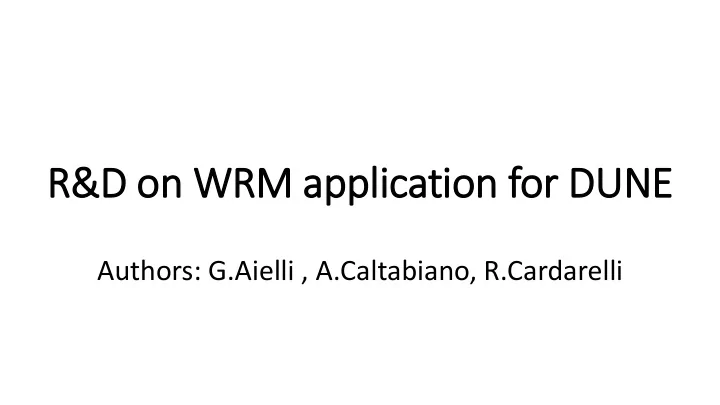

R&D on on WRM ap applicati tion f for D or DUNE Authors: G.Aielli , A.Caltabiano, R.Cardarelli
Technol ological p prop opos osal t the W WRM: • Low power consumption hardware • High throughput processing • Online data reduction In this r rep eport t will be p e pres esen ented ed: • An algorithm for pedestal subtraction • Software approximation of the WRM working principle and ROI extraction based on it • Comparison between ROI from WRM approximation and offline reconstruction ROI (from LArSoft reconstructed data) • Software performance estimation in order to prove WRM principle
The WRM in b brief • The WRM (Weighting Resistive Matrix) is a data analysis method based on analog computing techniques • The core processing is based on resistive networks, thus uses the energy of the input signal to carry out the computing • The principle works using charge diffusion as a weight function on the input data, while the likelihood distribution is obtained by summing up along one direction
The WRM in b brief • Depending on its design and implementation, the WRM technique can be applied to different use cases (i.e. edge detector, vertex detector, track reconstruction, hit finding,… ) • We base on software simulation of the algorithms running on proto-DUNE data for validation purpose
The WRM implementation for DUNE • We intend to exploit the WRM technology to enhance the local signal significance by exploiting its space-time correlation with respect to the noise • The original WRM design must be adapted to the DUNE data case: • Come already diffused on the time coordinate, with a typical shape due to the detector physics • We are interested at the smallest signals (a few wires) where the linear correlation are not yet meaningful • the signal is unipolar on the collection and bipolar on the induction planes, is biased by an offset
What w we would l like t to show with software: • The application of the WRM-like algorithm for both collection and induction planes (this last yet to be optimized). • Prove that WRM-like algorithm can reduce transmitted data (ROI) without information loss. • Compare transmitted data (ROI) from WRM-like algorithm with offline reconstruction ROI Technical proposal: • Apply the WRM as online ROI detector • Locate the WRM hardware between FELIX and hit finding system
Pedestal subtraction Al Algori rith thm: • for each wire where n is n-th time tick: 1. diff(n) = ADC(n+1)−ADC(n) (raw derivative) 2. diff(n)+diff(n+1) We use this algorithm because: • is simple to implement in hardware, introduce only latency in an online system • Works in both collection and induction views We will apply our WRM-like algorithm after pedestal subtraction and also on the intermediate step of it (1. raw derivative step). Thus, is possible to investigate the output of the same algorithm for both collection and inductions planes.
Raw aw Da Data f from Ev Event 5177 A 77 APA5 A5 Sam ample o of f two waveforms
Sam ample o of f two waveforms Pe Pedestal subtracted Da Data Ev Event 5177 A 77 APA5 A5
Our Our Gr Grou ound-truth :RO ROI from offl fline recon onstruction on From recob::Wire Library, Signal() accessor has been extracted: • if Signal() == 0 ..... save tick,channel,0 else ..... save tick,channel,1 From now on we refered to ROI from offline reconstruction with recob::Wire
recob:: ::Wire VS VS pedestal subtracted data ta
Ab About t reco cob::W :Wire vs pedestal subtracted data • Matching between data and offline ROI! • On induction plane recob::Wire as no enough selectivity then: 1. Recob::Wire could not be the right variable as ground-truth for induction planes 2. Is important (and convenient) research on a common strategy for both collection and induction planes with same performance and efficiency
WRM-like algori rithm: : descri ripti tion and perf rform rmance For both collection and induction planes • We are going to compare the amount of transferred data in function of the threshold for: 1. Simple threshold on pedestal subtracted data 2. Threshold on the output of a window sum (WRM-like algorithm) applied on the pedestal subtracted data 3. Threshold on the output of a window sum applied on diff(n)=ADC(n+1)-ADC(n) (raw derivative preprocessing) In order to compare the algorithms, thresholds are normalized by the maximum output value of each algorithm (i.e. for 1. th_max = max ADC)
Collection Plane event 5177 transmitted data vs ROI for fixed th normalized threshold
Visual comparison between offline ROI and WRM-like ROI ROI for fixed th ROI recob::wire
Induction Plane event 5177 transmitted data vs ROI for th used normalized threshold
Visual comparison between offline ROI and WRM-like ROI ROI for th used ROI recob::Wire
To To d do: • A quantitative estimation of efficiency is under development. • Tune WRM-like algorithm in induction planes in order to increase selectivity. • Find a valid ground-truth for induction planes. Nex ext ste steps are re: • Design and development of WRM hardware based on software results
Recommend
More recommend